What continents are on Earth - names, location on the world map and characteristics
However, depending on where you live, there may be five, seven or even four continents. This is due to the fact that there are no generally accepted international criteria for defining the term "continent". Although the position of the main land masses on the earth's crust can be described as continents, geopolitical factors also affect their demarcation.
Below is the most popular classification system, which identifies the six continents of the world in descending order of their area.
Eurasia
- Area: 54,759,000 km²;
- Population: 5,262,489,285 (2017);
- Number of sovereign states: more than 90.
Eurasia on the world map/Wikipedia
Eurasia is the largest continent on Earth both in terms of area and population. Almost all of its territory is located on the Eurasian Plate, one of several lithospheric plates that cover our planet. There is no geological difference between and, therefore, these parts of the world are united into the Eurasia continent.
The Ural Mountains are considered the dividing line between Europe and Asia. Eurasia extends from the Atlantic Ocean in the west to the easternmost, in the Bering Strait between the Arctic Ocean and the Pacific Ocean.
The mainland has different climatic conditions since it is located in all climatic zones, from the arctic to. In this regard, the continent has a significantly diverse flora and fauna. However, this does not apply to the European part of the world, where a temperate climate prevails, which does not contribute to significant.
Asia is the eastern part of Eurasia, which occupies about 30% of the entire land mass of our planet. About 60% of the world's population lives in this part of the world. It is home to endemic animals including the Asiatic, Indian cobra, and Japanese macaque. More than four billion people live in Asia. China is the world's most populous country, although India's population is predicted to overtake China in 2022. Asia is home to some of the world's most important economic centers, including Hong Kong, Tokyo, Shanghai and Seoul.
Europe is located in the western part of the continent. Despite being physically connected to Asia, Europe has historically been considered a separate continent due to cultural and linguistic differences. More than 10% of the world's population lives in Europe. Europe has the second highest population density in the world after Asia. Monaco is the most populous country in this part of the world. There are several countries in Europe that are considered transcontinental, that is, they are located in both Europe and Asia. These countries include Türkiye, Armenia, Georgia and Russia.
Africa
- Area: 30,370,000 km²
- Population: 1,225,080,510 (2016)
- Number of sovereign states: 54
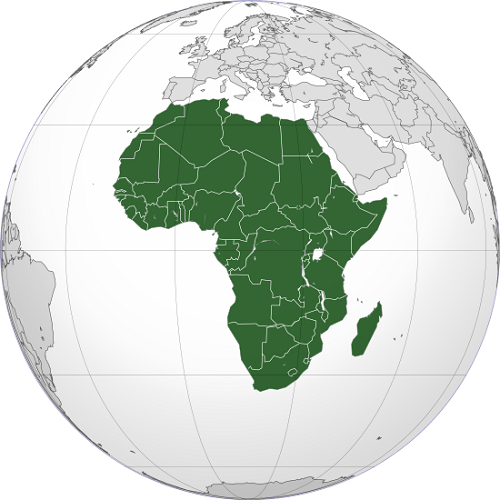
Africa on the world map/Wikipedia
Africa is the second largest continent in the world both in terms of land area and population. passes through the middle of the continent, dividing it into two parts. About one third of Africa is located in. The continent occupies about 20% of the total land area of the planet. The Indian Ocean, Atlantic Ocean, Mediterranean Sea and Red Sea border Africa to the east, west and north respectively.
The climate of Africa is characterized by hot in the north, jungles in both the central and southern parts. Africa has a lot of biological diversity and is home to the largest (elephants, hippos, rhinos and giraffes).
Africa has the youngest population of any continent, with an average age of just 19.5 years. This is the result of high population growth over the past 40 years. Africa is extremely linguistically diverse, with over two thousand languages on the continent. The largest city in Africa is Lagos, Nigeria.
North America
- Area: 24,709,000 km²;
- Population: 579,024,000;
- Number of sovereign states: 23.
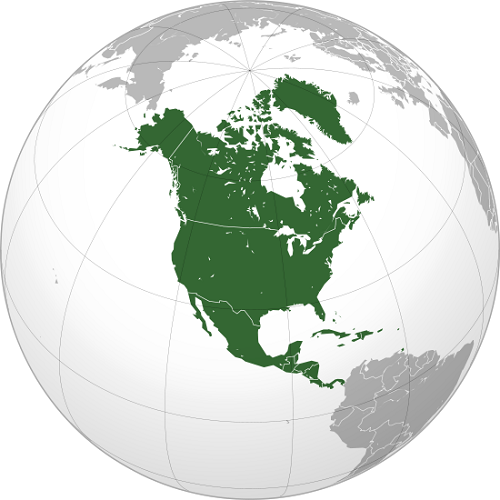
North America on the world map/Wikipedia
North America is the 3rd largest continent and the 4th most populous continent on Earth. North America lies entirely in and is washed by the Arctic Ocean to the north, the Atlantic Ocean to the east, the Pacific Ocean to the west, and the Caribbean Sea to the south. The continent has a coastline about 60 thousand km long.
The climate of North America is warmer in the south of the continent and colder in the north. While climatic conditions near the coast tend to be mild, temperatures inland can reach extremes. Although the southern part of the continent (including the south of the USA and Central America) is, and its northern part consists mainly of the arctic.
North America has an abundance of deposits, vast fresh water resources, and some of the most fertile soils on the planet. Thanks to this, the continent has become economically developed, and its population has a high standard of living.
The US is the most populated country in North America, followed by Mexico. The inhabitants of the mainland are characterized by ethnic diversity. English, Spanish and French are the most widely spoken languages on the continent.
South America
- Site area: 17,840,000 km²;
- Population: 420,458,044
- Number of sovereign states: 12.
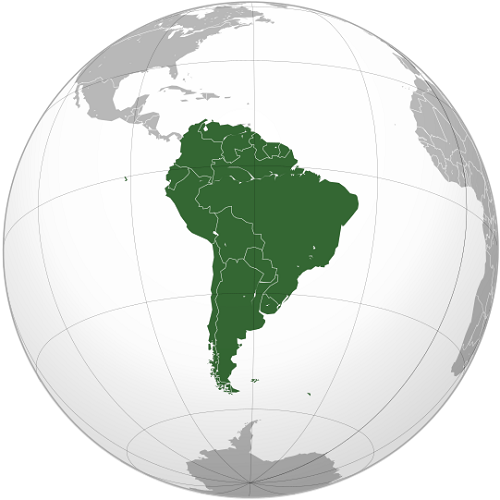
South America on the world map/Wikipedia
South America is the 4th largest continent in the world. It is mainly located in the Southern Hemisphere (with the exception of a small area of the northernmost part), and is also located entirely in the Western Hemisphere. South America is bordered by the Atlantic Ocean to the east, the Pacific Ocean to the west, the Southern Ocean to the south, and the Caribbean Sea to the north.
South America's climate ranges from the driest Atacama Desert to the lush Amazon. South America is home to amazing species and species, including unique tropical birds and monkeys. Some of the best known animals endemic to South America include the world's largest rodent, the world's largest flying bird, the Andean condor, and one of the world's largest butterflies, the morpho menelaus.
The importance of South America in terms of strategic natural resources is primarily determined by the abundance of minerals, biodiversity, forests, as well. After the Middle East, South America contains the largest oil reserves.
Brazil is the most populous country on the mainland, followed by Colombia and Argentina. Spanish is the most popular language in South America. English serves as the official language in Guyana and Dutch in Suriname.
Antarctica
- Area: 14,000,000 km²;
- Population: about 1,000 people;
- Number of sovereign states: 0.
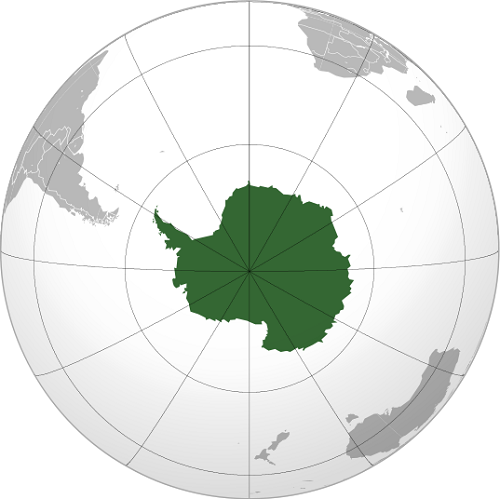
Antarctica on the world map/Wikipedia
Antarctica is located on and does not have a permanent population and countries. The mainland is used as a scientific base. Antarctica is the fifth largest continent and the least populated. It is completely surrounded by the Southern Ocean.
Strong winds, extremely cold temperatures, almost no weather, and a very cold desert make Antarctica's climate quite inhospitable. Despite this, a number of species have adapted to these difficult weather conditions. This includes seals, penguins, as well as some plants and.
Antarctica is completely surrounded by ocean, causing the sea ice to expand significantly in winter. It typically covers about 47 million km² during the September maximum (winter) and decreases to 8 million km² during the February minimum (summer).
The only human presence in Antarctica is the scientists who live on the mainland on a temporary basis. You can also visit Antarctica as a tourist.
Antarctica is the geographic opposite of the Arctic, which is an ocean half-covered by land masses. These surrounding lands impede the movement of ice, causing it to accumulate on high and thick ridges during the winter. During the warmer months, the Arctic retains about 47% ice (7-15 million km²).
Antarctic sea ice volume has increased by about one percent in the decade since 1979 and reached record levels in 2012-2014. However, these benefits do not compensate for the decrease in sea ice in the Arctic, and global sea ice continues to disappear at a rate of 35,000 km² (more than the area of Moldova) per year.
Australia
- Area: 7,659,861 km²;
- Population: 23,130,931;
- Number of sovereign states: 1.
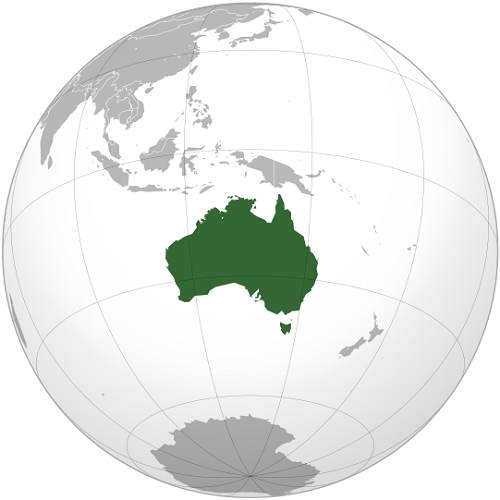
Australia on the world map/Wikipedia
Australia is the smallest continent in the world and the second least populated. It is located between the Indian and Pacific oceans. Although it is a large country, its topography is not very varied and most of it is desert. There are, however, fertile plains in the southeast.
Australia's climate ranges from tropical, arid and hot in the north to cooler in the south. Due to its isolation and remoteness from the rest of the world, the mainland exhibits a surprising number of endemic species. Some animals unique to Australia are the koala, platypus, wombat, kangaroo and echidna.
Although most of the continent is an arid desert, it supports a wide range of diversity, making it incredibly diverse. Due to the geographical isolation from the rest of the world, alpine forests, rainforests and a wide variety of plants and animals thrive. Thus, 85% of plants, 84% of mammals and 45% of birds are endemic to Australia. The mainland also has the largest number of reptile species in the world, as well as some of the most venomous snakes and other dangerous creatures such as crocodiles. Australia is best known for its cats, which include the kangaroo, koala, and wombat.
About 89% of Australia's fish species are endemic. In addition, endangered coral reefs are located near the coast of the continent. The most famous of them is the Great Barrier Reef. It is the world's largest coral reef system and covers an area of 344,400 km². It is made up of over 2,900 individual reefs and supports a variety of species, many of which are endangered.
Australia is considered a developed nation with a strong economy due to its vast natural resources, well-developed industry and tourism. Agriculture also plays an important role in the economy of the country and the mainland as a whole.




